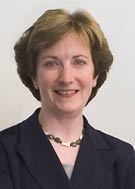New RSNA study finds 3-D breast imaging merits 'buzz'
by
Loren Bonner, DOTmed News Online Editor | November 21, 2012

Dr. Elizabeth Rafferty
The study that formed the basis of the Food and Drug Administration's approval of Hologic Inc.'s three-dimensional breast imaging technology called tomosynthesis--and subsequently its use in the clinical space--will be presented at RSNA's annual meeting next week.
"In the breast area this is the area of buzz," Dr. Elizabeth Rafferty, director of breast imaging at the Avon Comprehensive Breast Center at Massachusetts General Hospital in Boston and the study's lead author, told DOTmed News.
Unlike a screening digital mammogram, which involves two X-ray images of each breast, breast tomosynthesis, or 3-D mammography, captures a series of images at different degrees around the breast in 1-millimeter slices.
According to Rafferty, the novel technology advances the diagnostic accuracy of breast imaging because it addresses the two fundamental flaws of mammography: the inability to see some cancers on a mammogram and the increase in false positives that can lead to extra cost, unnecessary anxiety, and extra imaging.
"Both of those situations stem from the same culprit: these overlapping structures in the breast," says Rafferty. "Because tomosynthesis minimizes the impact of overlapping structures in the breast, it can actually lead to increased sensitivity and specificity, which can help us see cancers more easily and recognize them for the cancer they are."
Rafferty's multi-center study, published in the journal Radiology, involved 1,192 women recruited from five sites: Massachusetts General Hospital, the University of Iowa, Yale University, Dartmouth-Hitchcock Medical Center, and Magee-Womens Hospital of UPMC in Pittsburgh. Each of the women in the study underwent a standard digital mammogram followed by breast tomosynthesis. Nine hundred ninety-seven of those cases had complete data sets, including 780 screening cases and 217 women who needed pre-biopsy breast imaging.
According to a statement from RSNA, the use of both standard mammogram and tomosynthesis compared to digital mammography alone resulted in increased diagnostic accuracy for all 27 radiologists who read the exams. Additionally, the diagnostic sensitivity of the combined exam — or the rate at which cancer present in the breast was correctly identified — increased by 10.7 percent for radiologists in Reader Study 1 and 16 percent for radiologists in Reader Study 2. The two reader studies involved 312 and 310 cases, respectively.
Hologic's tomosynthesis technology, called the Selenia Dimensions 3-D System, was approved by the FDA in February 2011 and is not yet covered by most health insurance. A Hologic spokesperson told DOTmed News they had over 300 Selenia Dimensions 3-D Systems up and running in the U.S, and outside of the U.S., 29 countries have adopted the technology.
When DOTmed News spoke with Hologic back in May, it said it projected tomosynthesis will be its growth market over the next five years, especially as more independent clinical studies come out, many of which are already underway.
|
|
|
You Must Be Logged In To Post A Comment
|
